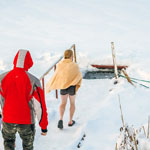Polar Bear Plunge Date in the current year: January 1, 2026
 A polar bear plunge, also known as a polar bear swim or a polar bear dip, is a winter-time event where participants dive into icy cold water. Polar bear swims are usually held as charity fundraisers, but in Canada they are also a New Year’s Day tradition.
A polar bear plunge, also known as a polar bear swim or a polar bear dip, is a winter-time event where participants dive into icy cold water. Polar bear swims are usually held as charity fundraisers, but in Canada they are also a New Year’s Day tradition.Winter swimming (ice swimming) is popular in Northern Europe, parts of Western Europe, Eastern European countries, China, Oceania, and North America. In many countries, winter swimmers are associated with a particular marine mammal; for example, they are commonly referred to as walruses in Slavic countries, as otters or seals in Finland, as seals in Latvia, and as polar bears in North America.
Taking into account the harsh Canadian climate, it is not surprising that the New Year’s Day tradition of polar bear plunges originated in Vancouver in 1920. Originally, members of the local Polar Bear Swim Club plunged into the icy water of the English Bay on Christmas Day, but at some point the annual plunge transformed from a Christmas tradition to a New Year’s Day one.
The first polar bear plunges in Vancouver involved a little over a dozen participants. However, over the years, the annual Vancouver Polar Bear Plunge has become a truly massive event with 1,000 to 2,000 registered participants. Since registration is optional, the actual number of participants may be considerably higher. In addition, up to 10,000 people come to observe the plunge every year.
Alongside Vancouver, annual polar bear plunges are held in other Canadian cities and towns, including Bowen Island, Calgary, Clarington, Edmonton, Halifax, Montreal, North Hatley, Oakville, Ottawa, Perth, Sarnia, St. John’s, Toronto, as well as the province of Prince Edward Island.
Canadian polar bear plunges are pretty spectacular: many swimmers dress up in funny costumes, and live music, hot drinks and snacks, various contests and family-friendly entertainment await swimmers and spectators on the shore. Another important aspect of polar bear plunges is charity; a lot of polar bear plunges double as fundraisers for various causes.
The tradition of New Year’s Day polar bear swims is almost sacred for many Canadians, so even the coronavirus pandemic couldn’t prevent people from plunging into icy water. Although mass events were banned in Canada in January 2021, people were encouraged to organize mini-polar bear dips in the safety of their homes (for example, dive into a pool of icy water, take an ice cold shower or an ice bath, etc.), film it, share the video on social media, and donate to charity if possible.
Outside Canada, New Year’s Day polar bear plunges are held in the Netherlands. The first Nieuwjaarsduik (“New Year’s dive”) was held in the seaside resort town of Scheveningen in 1960. Over the years, the tradition has spread all over the country, gathering tens of thousands of participants in nearly 90 locations.
In the United Kingdom, the majority of winter swimming events are held on Christmas Day or Boxing Day instead of New Year’s Day. The largest events take place in Brighton, Exmouth, and Lowestoft.
- Category
- Unofficial Holidays
- Country
- Canada
- Tags
- polar bear plunge, polar bear swim, polar bear dip, winter swimming, ice swimming, Canadian traditions